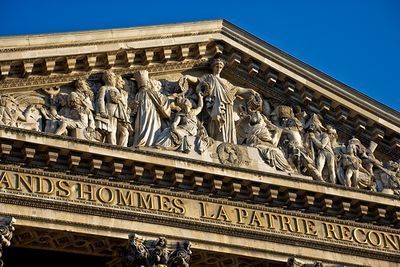The ‘people of the shadows’ enter the Panthéon
By ADRIAN TAHOURDIN
France doesn’t have an equivalent of Poet’s Corner in Westminter Abbey, which is perhaps surprising for a country that lionizes its writers. Presumably after the separation of church and state at the beginning of the last century, the idea of commemorating its writers in Notre Dame Cathedral would have been out of the question.
We know that France lionizes its writers from a glance at city and town street maps: Quai Voltaire, Boulevard Victor Hugo, Avenue Stendhal, rue Arthur Rimbaud and so on. And then there are the historical and political figures: you’d assume that the reason the main thoroughfare in Aix-en-Provence is called the Cours Mirabeau would be that the Revolutionary leader had been born there, but he wasn’t; he did serve there politically, however, elected to the Estates-General for the city in 1789. Elsewhere Napoleonic and World War One generals feature prominently – Avenue Jean Lannes, Avenue Gallieni, while every town and city seems to have an Avenue Maréchal Foch. And then there are the lycées: Lycée Paul-Valéry, Lycée Jean-Paul Sartre, Lycée Simone de Beauvoir . . . .
In Britain we seem to do things differently: our street names are resolutely unliterary – ok, there is Poet’s Corner in Acton (and an undistinguished Voltaire Road in Clapham), but it’s not exactly the Strand or Piccadilly. Perhaps we prefer to hide our literary lights under a bushel. And anyway our towns and cities don't have boulevards and avenues on the French model.
No Poet’s Corner then, but Paris does boast the chilly Panthéon in the Latin Quarter, with its famous inscription “Aux Grands Hommes La Patrie Reconnaissante”. Built as a church, it was deconsecrated during the Revolution when Mirabeau decreed that it should become a mausoleum for the great (he was the first to be interred there). Other residents in some shape or form include Voltaire, Rousseau, Victor Hugo, whose funeral procession in May 1885 was witnessed by huge crowds (and has been described by the historian Robert Tombs in his Introduction to Christine Donougher’s new translation of Les Misérables as one of the great state occasions of the century), Alexandre Dumas (controversially reinterred there in 2002), Émile Zola, Pierre and Marie Curie (the second woman to be buried there, and the first in her own right) and André Malraux. Then there is the Resistance hero Jean Moulin, who was tortured and murdered by the Nazis in 1943. President de Gaulle had his remains transferred to the Panthéon in 1964.
Moulin has now been joined by four other figures from the Resistance: two women (i.e. the third and fourth) and two men. Germaine Tillion (1907–2008), an anthropologist at the Musée de l’Homme, was betrayed and deported to Ravensbrück, from where she escaped weeks before the end of the war. She later took up the cause of Algerian independence. Also sent to Ravensbrück was Geneviève de Gaulle-Anthonioz (1920–2002), a niece of the General. She was liberated from the camp in April 1945, and gave evidence at the trial of the “Butcher of Lyon” Klaus Barbie in 1987. Jean Zay (1900–44) was a minister in the Front Populaire government and co-founder of the Cannes Film Festival (yes, it predates the war). He was assassinated by the collaborationist Milice. The journalist Pierre Brossolette (1903–44), who was something of a rival to Moulin, was tortured by the Gestapo and took his own life rather than betraying his accomplices. There are said to be nearly 500 streets in France named after him, but he has rather remained in Moulin's shadow..
Clockwise, Geneviève de Gaulle-Anthonioz, Germaine Tillion, Pierre Brossolette and Jean Zay
As Le Monde pointed out, the striking aspect of this decision to honour the quartet, rubber-stamped by President Hollande, is that they’re relatively little known to the public. The decision hasn’t met with unanimous approval: the historian Mona Ozouf calls it “coherent and indisputable”, while Pierre Nora, the historian and architect of the Lieux de mémoire volumes, finds it “striking that the 1914–18 war, whose centenary we are marking this year, should be absent [from the list of names of people being honoured]”. He suggests the Unknown Soldier. Yet according to him, the Resistance is the only element able to provide national cohesion in a divided country. Meanwhile the Bulgarian-born essayist (and co-author of a book on Tillion) Tzvetan Todorov reckons that the choice of Tillion and de Gaulle-Anthonioz is appropriate because their fight went beyond their time in the Resistance as they took up arms on behalf of the destitute and the colonized.
In his excellent book The Resistance: The French fight against the Nazis (2009), Matthew Cobb writes of how “Moulin was metaphorically resurrected in December 1964, when his ashes were buried in a moving state ceremony at the Panthéon. André Malraux, who was Minister of Culture and had played a minor role in the final stages of the Resistance, made a speech . . . that has entered French history. The oration turned into a shamanic invocation of the spirit of the Resistance as Malraux, in a voice trembling with emotion and cracked by decades of tobacco abuse, described the terrible sacrifice made by Moulin and ‘the people of the shadows’”.
Peter Stothard's Blog
- Peter Stothard's profile
- 30 followers





